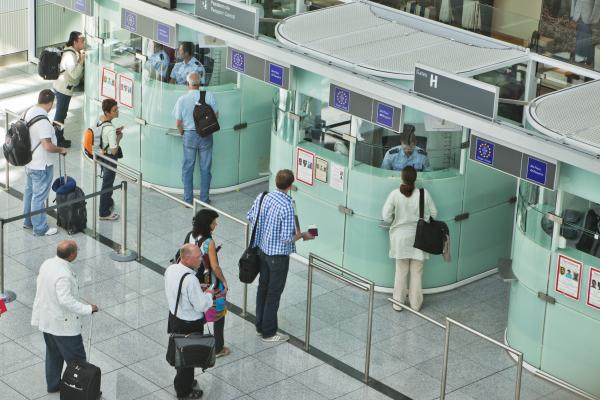The border-free Schengen Area guarantees free movement to more than 425 million EU citizens, along with non-EU nationals living in the EU or visiting the EU as tourists, exchange students or for business purposes (anyone legally present in the EU). Free movement of persons enables every EU citizen to travel, work and live in an EU country without special formalities. Schengen underpins this freedom by enabling citizens to move around the Schengen Area without being subject to border checks.
Today, the Schengen Area encompasses most EU countries, except for Cyprus and Ireland. Bulgaria and Romania became the newest Member States to join the Schengen area as of 31 March 2024, any person crossing the internal air and sea borders will no longer be subject to checks. Nevertheless, a unanimous decision on the lifting of checks on persons at the internal land borders is still expected to be taken by the Council at a later date. Additionally, the non-EU States Iceland, Norway, Switzerland and Liechtenstein also have joined the Schengen Area.
Freedom and security for travellers
The Schengen provisions abolish checks at EU's internal borders, while providing a single set of rules for controls at the external borders applicable to those who enter the Schengen area for a short period of time (up to 90 days).
The Schengen area relies on common rules covering in particular the following areas:
- crossing the EU external borders, including the types of visa needed,
- harmonisation of the conditions of entry and of the rules on short stay visas (up to 90 days),
- cross-border police cooperation (including rights of cross-border surveillance and hot pursuit),
- stronger judicial cooperation through a faster extradition system and the transfer of enforcement of criminal judgments,
- the Schengen Information System (SIS) and
- documents needed for travelling in Europe.
Police checks and temporary border controls
Any person, irrespective of their nationality, may cross the internal borders without being subjected to border checks. However, the competent national authorities can carry out police checks at internal borders and in border areas, provided that such checks are not equivalent to border checks. The non exhaustive list of criteria allowing to assess if police checks is equivalent to border controls is set out in the Schengen Borders Code. The Code is complemented by relevant case-law of the Court of Justice. It includes the following elements:
- the police checks do not have border control as an objective,
- are based on general police information and experience,
- are carried out in a manner clearly distinct from systematic border checks on persons at the external borders,
- are carried out on the basis of spot-checks.
The police carry out checks under the national law of the Schengen country. Depending on the exact purpose, they can, for example, include identity checks.
For more information on police checks in internal border areas see cases of the European Court of Justice C-188/10 (Melki), C-278/12 (Adil) and C-444/17 (Arib).
Temporary reintroduction of border controls
If there is a serious threat to public policy or internal security, a Schengen country may exceptionally temporarily reintroduce border control at its internal borders.
If such controls are reintroduced, the Member State concerned has to inform the Council (and thus, other Schengen countries), the European Parliament and the European Commission as well as the public. The Commission provides more information on the current reintroductions of internal border controls on the website: Temporary Reintroduction of Border Control.
The new Schengen Borders Code
In 2021, the Commission proposed to amend the Schengen Borders Code. The new rules, that were adopted in June 2024, introduced several measures to strengthen the governance and management of the Schengen Area and the EU’s external borders. The new rules introduce:
- Stronger external borders, with border measures to address the instrumentalisation of migrants;
- Reinforced framework for the use of cross-border police cooperation in border regions as an alternative to internal border controls;
- A revised framework for the possible reintroduction of internal border controls as a last resort measure, in a structured system with defined time limits and increased safeguards;
- New transfer procedure for irregular migrants, to assist EU countries with secondary movements within the EU;
- Travel restrictions for non-EU nationals at the EU's external borders during major health emergencies with common and simplified rules.
The new Schengen Border Code is a key delivery of the Strategy towards a fully functioning and resilient Schengen area, that the Commission presented in June 2021. The Schengen Strategy took stock of the progress made on the fundamental pillars of the Schengen area and other key measures sustaining the area of freedom, security and justice.
Criteria for countries to join the Schengen Area
Joining the Schengen Area is not merely a political decision of the joining State. Countries must fulfil a list of pre-conditions:
- apply the common set of Schengen rules (the so-called "Schengen acquis"), e.g. regarding controls of land, sea and air borders (airports), issuing of visas, police cooperation and protection of personal data,
- take responsibility for controlling the external borders on behalf of other Schengen countries and for issuing uniform Schengen visas,
- efficiently cooperate with law enforcement agencies in other Schengen countries, to maintain a high level of security, once border controls between Schengen countries are abolished,
- connect to and use the Schengen Information System (SIS).
Countries wishing to join the Schengen area must undergo a series of Schengen evaluations to confirm whether they fulfil the conditions necessary for the application of the Schengen rules.
Once the Schengen Evaluation confirms the readiness of the Member State to join the area without internal border controls, a unanimous approval from all other Member States applying the Schengen acquis in full is required.
Bulgaria and Romania have successfully accomplished the Schengen evaluation process set out in their Treaties of Accession, taking all the necessary measures to ensure application of all relevant parts of the Schengen acquis. On 30 December 2023, the Council unanimously agreed on the accession of Bulgaria and Romania to the Schengen area. Thus, as of 31 March 2024, both Member States will start applying Schengen rules. Controls at internal air and sea borders between Bulgaria and Romania and countries of the Schengen area will be lifted as of 31 March 2024. The Council agreed that a further decision should be taken at an appropriate date for the removing checks at internal land borders.
In addition, the Schengen evaluation process to assess the readiness to join the Schengen area is ongoing for Cyprus. The Schengen Information System in Cyprus was put into operation in July 2023 and this process was already verified by a dedicated Schengen evaluation in 2023.
For more information on the Schengen Evaluation and Monitoring mechanism see Schengen evaluation and monitoring.
Background: Free movement in Europe
Originally, the concept of free movement was to enable the European working population to freely travel and settle in any EU State, but it fell short of abolishing border controls within the Union.
A break-through was reached in 1985 in Schengen (a small village in Luxembourg), with the signing of the Agreement on the gradual abolition of checks at common borders, followed by the signing of the Convention implementing that Agreement in 1990. The implementation of the Schengen Agreements started in 1995, initially involving seven EU countries.
Born as an intergovernmental initiative, the developments brought about by the Schengen Agreements have now been incorporated into the body of rules governing the EU.
Related documents
- Communication on the full application of the Schengen acquis in Bulgaria, Romania and Croatia
- Report of the third voluntary fact-finding mission to Bulgaria - latest developments in the application of the Schengen acquis
- Report of the voluntary based fact-finding mission to Romania and Bulgaria on the application of the Schengen acquis and its development since 2011
- Report of the complementary voluntary fact-finding mission to Romania and Bulgaria on the application of the Schengen acquis and its developments since 2011
- Notifications under Article 19 of Regulation (EC) No 1931/2006 of the European Parliament and of the Council of 20 December 2006 laying down rules on local border traffic at the external land borders of the Member States and amending the provisions of the Schengen Convention List of notifications of bilateral agreements under Article 19 of Local Border Traffic Regulation
- Notifications under Article 14 (5) of Regulation (EC) No 2016/399 of the European Parliament and of the Council of 09 March 2016 on a Union Code on the rules governing the movement of persons across borders (Schengen Borders Code) (codification). Statistics on the number of persons refused entry at the external borders of EU States
- List of notifications under Article 39 (Schengen Borders Code) (codification)
- List of border crossing points (consolidated version)
- List of residence permits (consolidated version)
- Reference amounts for crossings of the EU’s external borders (overview and consolidated version)
- List of national services responsible for border control (consolidated version)
- Model cards issued by the Ministries of Foreign Affairs of the Member States to accredited members of diplomatic missions and consular representations and members of their family (consolidated version part 1 and part 2)
- List of specimen of residence permits (consolidated version part 1 and 2)
- Notifications under Article 42 of Regulation (EC) No 2016/399 of the European Parliament and of the Council of 09 March 2016 on a Union Code on the rules governing the movement of persons across borders (Schengen Borders Code) (codification)
- Lists of notifications under Article 42 (Schengen Borders Code) (codification)
- Commission Implementing Decision establishing the report of 2019 - 2020 thematic evaluation of Member States` national strategies for integrated border management and Annex 1
- Commission report on the functioning of the Schengen evaluation and monitoring mechanism, First multi-annual evaluation programme (2015-2019)
- Commission report (2015) 675 on the functioning of the Schengen area
- Commission report (2013) 326 on the functioning of the Schengen area
- Commission report (2012) 230 on the functioning of the Schengen area
- Commission report COM (2010) 554 on internal borders


